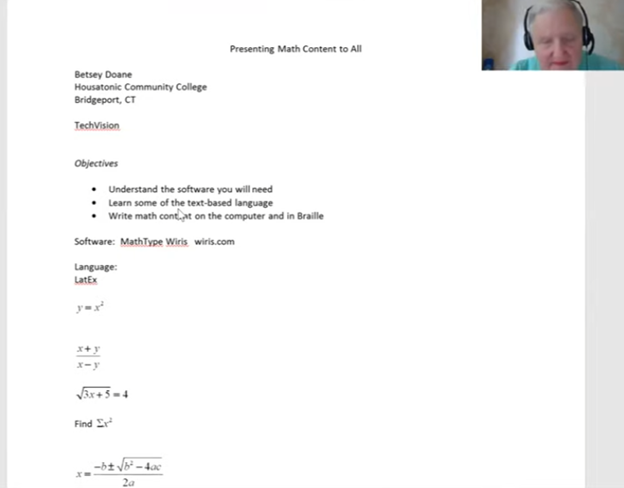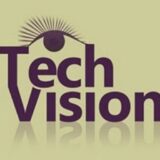Dr. Betsey Doane shared her experience teaching math for over 50 years and the importance of making math accessible to all students, including those with visual impairments. She began by introducing the software MathType, essential for creating accessible math content. The software integrates into Word and allows users to write math that is accessible to both screen readers and braille displays. Her efforts truly embody the concept of Advanced Math Made Accessible.
Dr. Doane explained the basics of LaTeX, a text-based language used for writing math. She demonstrated how to input and translate common math expressions such as fractions, square roots, and equations using LaTeX in Word. Her instructions included using the Focus 40 Braille Display and ensuring proper configurations for students to view math content in braille. This approach makes advanced math more accessible for everyone.

She emphasized the importance of understanding both the visual and non-visual ways of presenting math, highlighting that students need the right software and commands to work effectively. By using LaTeX and MathType, both sighted and blind students can access and solve math problems, ensuring inclusion in any classroom setting. This makes advanced math accessible and easier to understand.
She highlighted the use of MathType software, which integrates seamlessly with Microsoft Word, allowing users to create and present math content that is accessible through screen readers like JAWS and braille displays like the Focus 40. Dr. Doane explained how MathType enables students and educators to write complex equations, such as fractions, square roots, and exponents, in both visual and non-visual formats. This ensures that blind students can access the same content as their sighted peers, making advanced math more accessible.
Advanced Math Made Accessible with LaTex
Dr. Doane also provided an introduction to LaTeX, a powerful text-based language used for writing mathematical expressions. She demonstrated how to write math using LaTeX syntax, such as using backslashes for commands like fractions and square roots. By using LaTeX in Word with MathType, math content can be rendered correctly on both screen readers and braille displays, making it easier for blind students to follow along in class and complete assignments. This is another way to make advanced math accessible.
Furthermore, Dr. Doane stressed the importance of configuring braille displays correctly, ensuring that input is set to computer braille and output is set to grade 2. She provided step-by-step instructions for adjusting these settings on the Focus 40 Braille Display, ensuring that students can navigate math content effectively, contributing to the overall goal of making advanced math accessible.
In conclusion, Dr. Doane encouraged educators to adopt these tools and techniques to create an inclusive learning environment where both sighted and blind students can excel in mathematics. Her detailed instructions and practical advice offer a clear path toward accessible math education for all.
Other Math Lessons
Hayes learns proper Word setup for Math with Math Editor and Jaws commands with brailliant display
Setting up Braille Math editor in WORD to left justify and work in computer and contracted braille
UEB Math Lessons Galore with JAWS or NVDA
Digital UEB Math & Braille Math Editor in WORD with JAWS UEB Mode
UEB Math using Braille Math and Word Math Editors with Jaws and split-braille-for-buffer-mode
UEB Math with NVDA in WORD using unicode-LaTex or Braille -easy to advanced math
Digital Math with UEB Math, NVDA completing Matrices in WORD Math Editor 365
JAWS or UEB Math in WORD Math Editor-Unicode-LaTex Braille=learning easy to advanced math
Quadratic Formulas with UEB Math or Nemeth and/or display with JAWS audio & MathCat
Matrices in WORD Math Editor-Braille Math editor with Jaws using LaTex, auditory and/or Braille
MathKicker. AI- Solutions to Math Issues
Digital Quadratic Math with Jaws or NVDA in Mathkicker.ai – auditory and/or braille display
Complete Advanced Math with LaTex to finish math fast using Mathkicker.AI, JAWS, NVDA and/or display
Math & AI =Mathkicker.ai convert PDF math or any work into WORD docx.
Perfect Digital Math at all levels using only audio or tactile Braille or both in Mathkicker.ai
Math & AI is MathKicker.ai — convert to .docx from clipboard- make inaccessible accessible
Mathkicker.ai-take an image of math and make it perfect Math in Word Math editor with screen reader
Mathkicker.AI -change Math PDF to text in WORD Math editor in less than a minute with screen reader
Graphing, Split Braille and More
Transcribe Math into Word documents for blind students using Math editor, Jaws and a Braille Display
Quadratic equation and how to fix math mistakes, braille math editor, Jaws in Word Math editor
Braille Math in Word with editor, JAWS, braille display and ease for multi-line math problems
Graphing Inequalities, functions and shading with Desmos and screen reader
Create Geometry Shapes from Math Work in Desmos with screen reader
Geometry in DESMOS graphing Calculator with screen reader
Desmos graphing calculator with shaded Parabolas, screen reader, braille display and embosser
Students with Math
Braille Math editor Contracted out, computer in mode with Tay–most efficient
Jaws Braille Math editor in Word by Aubrey
Braille Math Editor in Word with Jaws, Focus Braille Display by Campbell
And Even 3 fingers can do all of these lessons
And start with IXL on a display
